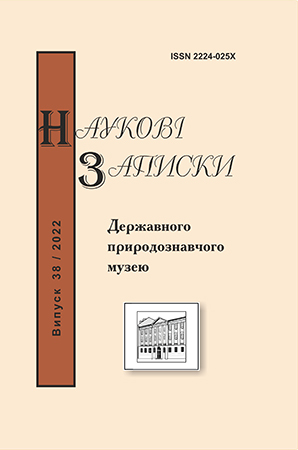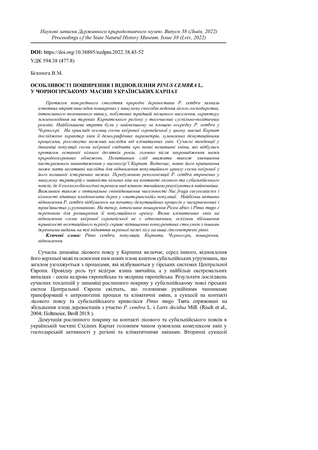Bilonoha V.M.
Characteristics of spread and restoration of Pinus cembra L. in the Chornohora massif of the Ukrainian Carpathians // Proc. of the State Nat. Hist. Mus. - Lviv, 2022. - 38. - P. 43-52 DOI: https://doi.org/10.36885/nzdpm.2021.38.43-52 Key words: Pinus cembra, population, Carpathians, Chornohora, restoration During the previous century, natural stands of Pinus cembra suffered significant losses due to the unreasoned methods of forestry, animal husbandry, cultural traditions of the local population, and the way of land possession in the Carpathian region in the past socio-political realities. The largest losses have occurred in the smallest habitats of P. cembra in the Chornohora massif. The case study in this part of the Carpathians involved changes of demographic parameters of Swiss stone pine population due to restoration succession processes in its habitats. Possible effects of climate change are also considered. Current trends in the population dynamics of Swiss stone pine indicate certain positive changes that have taken place over the past few decades, mainly after the introduction of some environmental regulations. Grazing pressure reduction in the highlands of the Carpathians should also be considered positive. At the same time, its complete cessation may have negative consequences for the restoration of the Swiss stone pine habitats within its former historical boundary. Necessary condition for recolonization of the lost territories by P. cembra is the presence of free niches at the upper forest or subalpine zones, where its ecological and biological advantages over spruce are fully realized. Another important factor is the optimal ratio between the number of Nucifraga caryocatactes and the number of fruit-bearing trees in the "mother" population. The most active recovery of P. cembra occurred at the beginning of the restoration succession in shrubby and herbaceous patches. At present, the intensive spread of Picea abies and Pinus mugo is an obstacle to the expansion of its population range. The impact of climate change on the restoration of Swiss stone pine is not obvious, as prolongation of the growing season enhances competition with other tree species while the timberline raises higher hypsometric levels.
Characteristics of spread and restoration of Pinus cembra L. in the Chornohora massif of the Ukrainian Carpathians // Proc. of the State Nat. Hist. Mus. - Lviv, 2022. - 38. - P. 43-52 DOI: https://doi.org/10.36885/nzdpm.2021.38.43-52 Key words: Pinus cembra, population, Carpathians, Chornohora, restoration During the previous century, natural stands of Pinus cembra suffered significant losses due to the unreasoned methods of forestry, animal husbandry, cultural traditions of the local population, and the way of land possession in the Carpathian region in the past socio-political realities. The largest losses have occurred in the smallest habitats of P. cembra in the Chornohora massif. The case study in this part of the Carpathians involved changes of demographic parameters of Swiss stone pine population due to restoration succession processes in its habitats. Possible effects of climate change are also considered. Current trends in the population dynamics of Swiss stone pine indicate certain positive changes that have taken place over the past few decades, mainly after the introduction of some environmental regulations. Grazing pressure reduction in the highlands of the Carpathians should also be considered positive. At the same time, its complete cessation may have negative consequences for the restoration of the Swiss stone pine habitats within its former historical boundary. Necessary condition for recolonization of the lost territories by P. cembra is the presence of free niches at the upper forest or subalpine zones, where its ecological and biological advantages over spruce are fully realized. Another important factor is the optimal ratio between the number of Nucifraga caryocatactes and the number of fruit-bearing trees in the "mother" population. The most active recovery of P. cembra occurred at the beginning of the restoration succession in shrubby and herbaceous patches. At present, the intensive spread of Picea abies and Pinus mugo is an obstacle to the expansion of its population range. The impact of climate change on the restoration of Swiss stone pine is not obvious, as prolongation of the growing season enhances competition with other tree species while the timberline raises higher hypsometric levels.
References
- Кияк В., Кобів Ю., Жиляєв Г., Білонога В., Дмитрах Р., Микітчак Т., Решетило О., Кобів В., Нестерук Ю., Штупун В., Гинда Л. 2018. Зміни структури популяцій рідкісних видів високогір’я Українських Карпат і проблеми їх збереження. За ред. В. Кияка. Львів : Вид-во ННВК «АТБ». 280 с.
- Сіренко О.Г. 2005. Поширення та регресивні зміни ареалу сосни кедрової європейської (Pinus сembra L.) в Українських Карпатах. Інтродукція рослин, № 1. С. 11–16.
- Сіренко О.Г. 2008. Сосна кедрова європейська (Pinus cembra L. В Україні: хорологія, структура популяцій та охорона. Автореферат дисертації кандидата наук. Київ. 23 С.
- Barbeito, I., Dawes, M.A., Rixen, C., Senn, J., Bebi, P. 2012. Factors driving mortality and growth at treeline: A 30-year experiment of 92 000 conifers. Ecology. 93(2). P. 389–401.
- Blada I. 2008. Pinus cembra distribution in the Romanian Carpathians. Annals of forest research. 51. P. 115–132.
- Boden S., Pyttel P., Eastaugh C.S. 2010. Impacts of climate change on the establishment, distribution, growth and mortality of Swiss stone pine (Pinus cembra L.). iForest - Biogeosciences and Forestry. Vol. 3 Issue 4. P. 82-85. DOI: 10.3832/ifor0537-003
- Giammarchi F., Vacchiano G., Bertagnolli A., Ventura M., Panzacchi P., Cherubini P., Tonon G. 2017. Effects of the lack of forest management on spatiotemporal dynamics of a subalpine Pinus cembra forest. Scandinavian Journal of Forest Research. Vol. 32 Issue 2. P. 142 – 153.
- Heinze B., Holzer K. 2013. A review of research on Pinus cembra in Austria, with special reference to the conservation of genetic resources. 5th Symposium for Research in Protected Areas, Mittersill. P. 279 – 283.
- Holtmeier F.-K., Broll G. 2018. Subalpine forest and treeline ecotone under the influence of disturbances: a review. Journal of Environmental Protection. 9. P. 815-845. DOI: 10.4236/jep.2018.97051
- Loranger H., Zotz G., Bader M.Y. 2017. Competitor or facilitator? The ambiguous role of alpine grassland for the early establishment of tree seedling at treeline. Oikos. Vol. 126 Issue 11. P. 1625-1636. DOI: https://doi.org/10.1111/oik.04377
- Oberhuber, W., Bendler, U., Gamper, V., Geier, J., Hölzl, A., Kofler, W., Krismer, H., Waldboth, B., Wieser, G. 2020. Growth trends of coniferous species along elevational transects in the Central European Alps indicate decreasing sensitivity to climate warming. Forests. 11(2). No. 132. P. 1-13. DOI: https://doi.org/10.3390/f11020132
- Risch A.C., Schütz M., Krüsi B.O., Kienast F., Wildi O., Bugmann H. 2004. Detecting successional changes in long-term empirical data from subalpine conifer forests. Plant Ecology. 172. P. 95-105. DOI: 10.1023/B:VEGE.0000026040.01175.7c
- Sitko, I., Troll, M. 2008. Timberline changes in relation to summer farming in the Western Chornohora (Ukrainian Carpathians). Mountain Research and Development. 28(3). P. 263–271. DOI: https://doi.org/10.1659/mrd.0963
- Szafer W. 1914. Limba (Pinus cembra L.) u źródeł Łomnicy. Sylwan. T. 32 №. 6. P. 212–217.
- Środoń A. 1937. Rozmieszczenie limby w polskich Karpatach i jej ochrona. Ochrona Przyrody. 17. P. 22–42.
- Tołpa S. 1928. Z badań nad wysokogórskiemi torfowiskami Czarnohory. Acta Societatis Botanicorum Poloniae. Vol. 3. P. 221–245.
- Tomback D.F., Holtmeier F.-K., Mattes H., Carsey K.S., Powell M.L. 1993. Tree Clusters and Growth Form Distribution in Pinus cembra, a Bird-dispersed Pine. Arctic and Alpine Research. 25. 4. P. 374–381.
- Wierdak S. 1927. Nieco o rozsiedleniu limby w Karpatach Wschodnich. Sylwan. T. 45. P. 201–207.
- Wilczyński T. 1930. Roślinność pasma Czarnohory. Krajobrazy Roślinne Polski. Z. 17. P. 27–28.
- Zięba A, Różański W., Szwagrzyk J. 2020. Structure of Dominance among Tree Species in Relic Swiss Stone Pine (Pinus cembra L.) Forests in Tatra Mountains. Polish Journal of Ecology. 68(2). P. 159–171.


